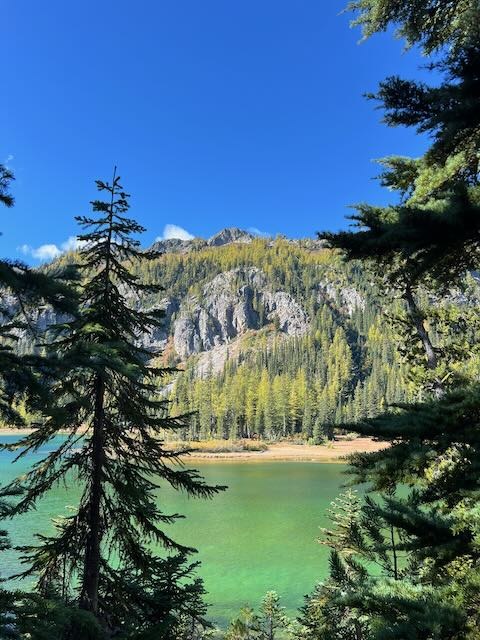Summary: With my trusty Golden Retriever, I squeezed a fun, challenging shoulder-season 4 night lollipop-ish route thru the Entiat. We hiked past Myrtle Lake and Cow Creek Meadow, camped amidst Larch Lakes, crossed Pomas Pass into the Ice Creek drainage and then went up to Lower Ice Lake. Weather was mostly great, trails in good condition - but not without challenges in terrain and route-finding. We had the trails to ourselves: passed a family of 3 heading out as we came in, at about 3 mi from the trailhead. At about the same spot heading out, we passed a solo hiker heading in. That's it!
Water was never a problem, bugs were nonexistent. We encountered over a dozen trees across the trail on our first day - most of which had been cleared by our hike out. After that 1st day, trail obstacles were few. Thanks to the USFS and WTA BCRTs for fine work on clearing trail.
I’d been wanting to explore the Entiat for several years. Got my first taste of its beauty while working a WTA BCRT in '23 and another in ’24, and wanted a chance to explore and discover it on my own. This seemed a perfect opportunity.
Day 1 we hiked up the Entiat River Trail, took the left to go past beautiful Myrtle Lake and continued up past Cow Creek Meadows to the Garland Peak Trail, continuing down to camp on the west side of Upper Larch Lake. Apart from the windfalls in the first 4 miles, the upper stretches of Cow Creek Trail remained mostly clear as was Garland Peak Trail. Larch Lake is gorgeous – but the big climb followed by the descent to the lake left me and my legs cooked! I made us dinner and we crashed early.
Day 2 we woke to a planned "lag day" where we'd explore the Larch basin; I wanted to get another look at the falls draining Lower Larch. But that drainage wasn't flowing as well as it was in my June visit (with all the snow-melt assist). We returned to camp for lunch and shelter - anticipating a forecast of "heavy rain" and "strong" 10-12 mph winds, and wanting to be near shelter. The wind started as forecast at about 3p, the rain following shortly after – but it never amounted to much more than a modest rain. The wind, OTOH, got to howling. Based on comparison to the Beaufort scale I estimate windspeed closer to 30-35 mph, which continued thru the afternoon, evening and all night, until subsiding by about 10a on Day 3. The overnight winds several times flattened the low end of my tent; each time it flexed back. So impressed with modern tent designs: I grew up in Boy Scouts using US Army shelter halves, which never would have survived the night!
Day 3: once the wind died, we broke camp, packing up and continuing north on the Garland Peak Trail to a clear junction with the Larch Lakes Trail, turning left (uphill), destination Pomas Pass. The climb up to 6900’ was uneventful; the climb DOWN to Pomas Pass was, for much of the way, a steep sidehill - some of it, not for the faint-of-heart. The Pass itself offered pretty views in both directions. I’d read a recent USFS report indicating the trail had been cleared between the Pass and Ice Creek Trail, and can confirm this to be the case. There were a few windfalls to clamber over, some brushy spots, a few rock fields thru which the route was not overly evident, but all passable. Shortly after re-entering the burn zone at about 5600 ft, I did lose the trail - I missed the turn - where the trail turns downhill from the sidehill (the way obstructed by a large downfall). There’s a nice camp at the bottom of Pomas Creek Trail just before emerging to the junction with Ice Cr Tr. We turned west on Ice Cr Tr for 1.5 mi to a nice camp on the east side of the creek.
Day 4: we got out early with dayhike gear and made quick work reaching the camp at the base of the trail up to Ice Lakes; there was some gorgeous forest walking along the way. From that camp, the trail stayed just west of the route shown in USFS maps, mostly in a drainage gully - closer to what’s shown in OpenStreetMaps. The going gets pretty steep, and then steepens a few times more until reaching the Lower Ice Lake basin. The view is spectacular. We saw the first people we’d seen since Day 1 - with fishing poles on the other side of the lake. After a too-brief stop, I felt that given our schedule constraints, we had to ignore some great advice to proceed to the Upper Lake, and instead turn back to camp. The descent proved particularly challenging to my faithful canine companion, who expressed hesitancy in taking a few of the 3’ straight-down-steps required to make progress. Our negotiations were ultimately successful, we reached the camp at the upper end of the valley, and then proceeded back to our cached gear on the E side of the creek. We packed up the rest of our gear and continued east; after crossing the Entiat on a nearby log, camped at the dusty horse camp at the junction of Ice Creek Tr with the Entiat River trail.
Day 5 we hiked out to the car; most / all of this hike is thru the burn zone. The burned out carcasses of trees lost to the fires is offset by the impressive new growth as the forest slowly returns to a sense of health. That health evidently has a long ways to go, but its coming. Along the way we spoke to our 1st human since Monday, a fellow solo hiker, about 3 miles before the trailhead. Back to the car we packed up, wiped down and headed home.







Comments